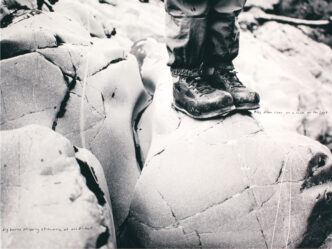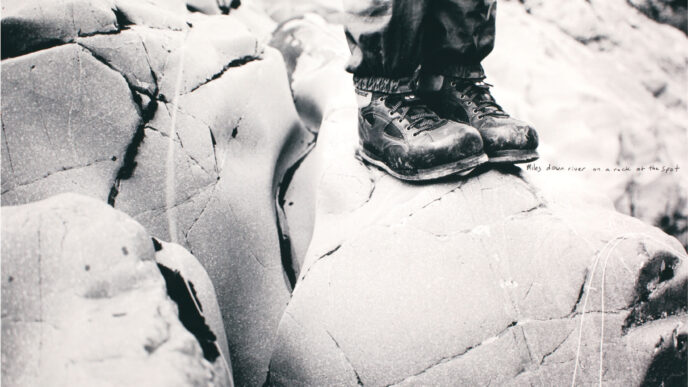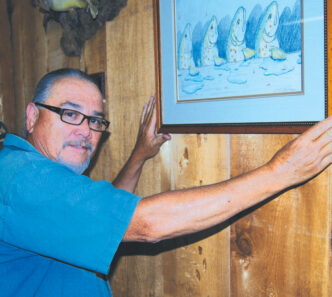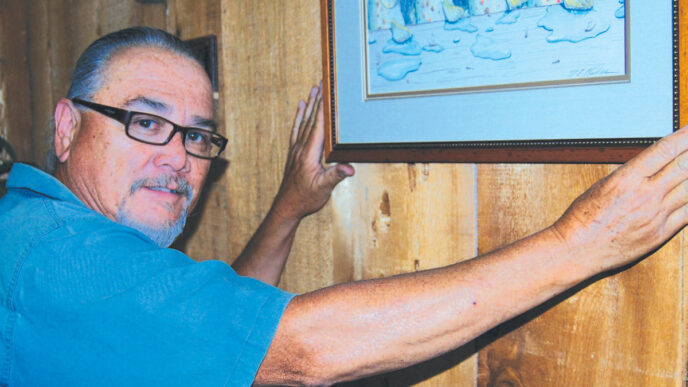If you’ve read pretty much anything that Ralph Cutter has written in this magazine, or anywhere else, for that matter, you’ve already met Lisa Cutter. She is always by his side — not just in the byline on his columns here, but in his accounts of his adventures and researches. When Ralph emerges from a particularly hairy scuba dive on a frozen-over Sierra lake, there is Lisa, holding the safety rope and with a welcoming bottle of tequila at the ready. You’ve seen her picture on the cover of California Fly Fisher and her artwork in the magazine, but even though she has been the principal instructor at the Cutters’ long-running and much-acclaimed California School of Fly Fishing and a Federation of Fly Fishers accredited casting instructor (and some say a better caster than Ralph), and even though she was inducted with Ralph into the Northern California Council of the Federation of Fly Fishers Hall of Fame in 2000, not enough people know Lisa Cutter in her own right. We’re going to fix that right now.
Bud: Most of what’s publicly available about Lisa Cutter actually is about “Ralph and Lisa Cutter.” I’ll get to that partnership eventually, but I’d like to find out more about you as you. I’ve read that for your honeymoon, you and Ralph went on an extended backpacking and fishing trip. So let’s start the story with a flashback that ends at that point.
Lisa: On our first date, we took parachute lessons in Pope Valley, near Lake Berryessa. For our second date, we went backpacking to Nydiver Lake in what was to become the Ansel Adams Wilderness. It was my first pack trip and where I caught my first fish on a fly. It was a huge brook trout at the outlet of Nydiver. My second pack trip, our honeymoon, we spent six months hiking the California segment of the (proposed) Pacific Crest Trail in 1976. When we got married, he was 20, and
I was 19. We wanted to do something “really fun” for our honeymoon, which has been the theme of our relationship ever since. With the possible exception of taking LSD, the hike was probably the most profound experience of my life and shaped the person I am today. The only material goods we had were on our backs. We woke up with the sun and lay down with the sun. It was a rhythm so basic, yet so profound, I still can’t describe or explain it. I still have the five-pound Lowa Alpspitz boots — they make great doorstops.
I grew up in Walnut Creek when there were actually walnut groves and a Walnut Creek. I rode my horse in the Walnut Parade every year, graduated from high school a year early, not because I was so smart, but because the school just bored me. I then went to Diablo Valley College for a couple of years and devoured all the art, technical drawing, and architecture classes. I met Ralph at DVC, where he was a part-time student. Soon after we met, we moved to San Diego, and I went to San Diego State, enrolled in the Environmental Architecture Program, while Ralph went to Mesa College. We lasted less than a year there. Living without seasons just didn’t work for us. That’s when we quit school.
Growing up, I was lucky enough to live where I could be outside most of the time, either riding my horse through the Los Trampas Hills, climbing trees, or catching snakes, tarantulas, and scorpions. I had a collection of dead bugs in a box under my bed just in case I needed to scare someone. In a nutshell, I loved being outside back then, just as I do now. Deciding to hike the PCT was a no-brainer.
I caught my first fish around the age of eight. It was a brown trout on a worm in the upper reaches of Prosser Creek, near Truckee. No one in my family fished, so that was my one and only experience with fishing until I met Ralph. He taught me how to use a fly and a bubble, and I loved it.
Soon after hiking the PCT, we moved to Squaw Valley and signed up for a flyfishing class being taught down the road by some guy named Mel Krieger. My passion for hiking, rock climbing, and skiing was quickly equaled by that of fly fishing. Little did I know that only a few years later, we would be hosting some of Mel’s overseas fly-fishing trips.
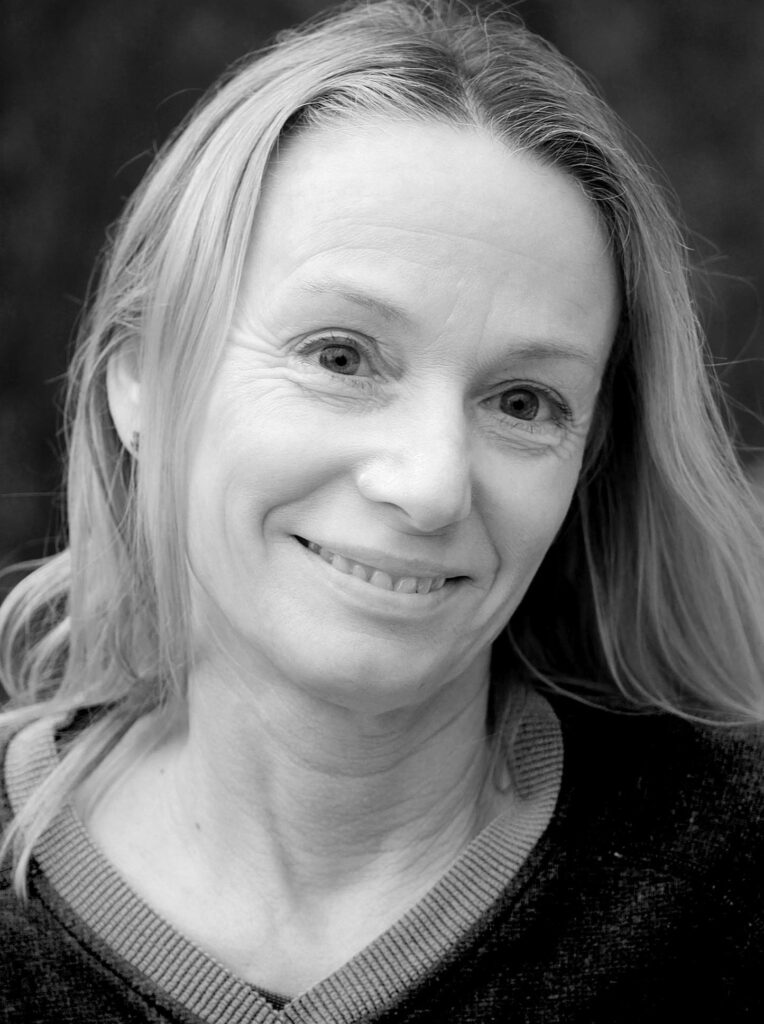
Bud: You’ve done artwork for some of the things we publish in this magazine, and you’re also a professional artist. Tell me about Lisa’s Architectural Models.
Lisa: Before I met Ralph, I was going to be an architect. He quickly made me realize that life could be so much more enjoyable that I quit college and started a life of fun. As we all know, fun needs money, too, so I fell back on a talent that came naturally to me. I was born with the gift of seeing things in my mind and duplicating them spatially in 3-D. My parents tell me that even at five, I was looking at my dad’s blueprints and drawing houses from them. Soon, I was drafting my own blueprints and building structures. At 16, I won a national award from the American Institute of Woman Architects for an underground house I designed and for the scale model I built of it. They didn’t know how old I was until I showed up to receive the award and give an acceptance speech at the Fairmont in San Francisco. I was terrified.
From the mid-1980s until 2010, the Tahoe-Truckee area experienced a building boom of high-end houses and resorts for which architects needed scale models. I was in the right place at the right time, and with little or no competition, I could make my own hours, name my price, and most importantly, could work from home and be with our kids. During the winter, I made models, and during the summer, I fished. I definitely had conflicts about the size and scale of the building taking place in such a beautiful part of the world . . . but hey, I’m just the model maker.
We architectural model makers are going the way of the dinosaur and being replaced by virtual modeling. I really do miss making models and using a part of my brain that is far removed from the art of fishing. I love to draw, but admittedly have a hard time sitting down and putting ink to paper when there is fishing to be had, bees to tend to, or some nice garden soil to smell and dig my hands into.
Bud: The California School of Fly Fishing has been around since 1981 — 33 years and counting. How did it get started, and when did you become an FFF certified casting instructor?
Lisa: When we first started the fly-fishing school in 1981, it was really only Ralph guiding and teaching by himself and also working as an instructor for Mel Krieger and Orvis. Ralph got more business than he could handle, and within a few years, I was also guiding and hosting trips. It was not long before we realized that we had created a serious business and were no longer dabbling in a hobby. It didn’t take Donald Trump to figure out that 10 or more hours a day guiding a single client was an inefficient way to run a business and didn’t pencil out nearly as well as teaching larger groups.
Like making models, it turned out that we were in the right place at the right time to start a fly-fishing school. In 1992, “The Movie” came out, and a few months later, it got an Academy Award and I got an FFF casting instructor’s certification. I taught introductory courses to small groups while Ralph was losing sleep at the firehouse, where he was working as an EMT, and on his days off, we would coinstruct the larger classes.
Bud: For most of that period, there’s been a somewhat muted and mutating, but persistent set of gender issues in American fly fishing, ranging from the treatment of women who walk into fly shops to the availability of gear sized for women, with a whole lot in between, including macho behavior on-stream (and off ) that overlaps with issues of angling etiquette and just plain common decency. You get to deal with these directly in your work with the fly-fishing school. So here are a few questions related to that.
What has changed in the attitude toward fly fishing that your female students bring to the sport since 1981? Have the attitudes of male students changed toward women in fly fishing? It is, at bottom, a blood sport, even with the catch-and-release ethic. Does that characteristic matter in terms of gender differences?
Lisa: Over the years, I think there has been and still is a gradual shift in women expressing greater confidence in themselves and being more self-reliant in general. It only follows that this confidence and self-reliance would be expressed in fly fishing, as well as in life in general. Men’s attitudes have changed as they have experienced the women around them successfully doing things that were once a man’s domain. When I first started guiding 30 years ago, it was not uncommon for a man to ignore my advice, even though he was paying me to help him catch fish. I can’t say that has happened once in the past decade.
Yes, unfortunately, fly fishing is a blood sport. When I inadvertently maim or kill a fish, a little bit of me questions my motives. I could think it to death and quit fishing altogether or rationalize the sport in terms of some instinctual hunter/gatherer fulfillment, but the truth is, the enjoyment I get out of fishing more than offsets any fleeting misgivings.
I haven’t seen much difference between men and women and their capacity to enjoy fishing. Women may tend to appear to be more turned off by a “blood sport” than men, but I think that is only because women are more willing to express their emotions in general.
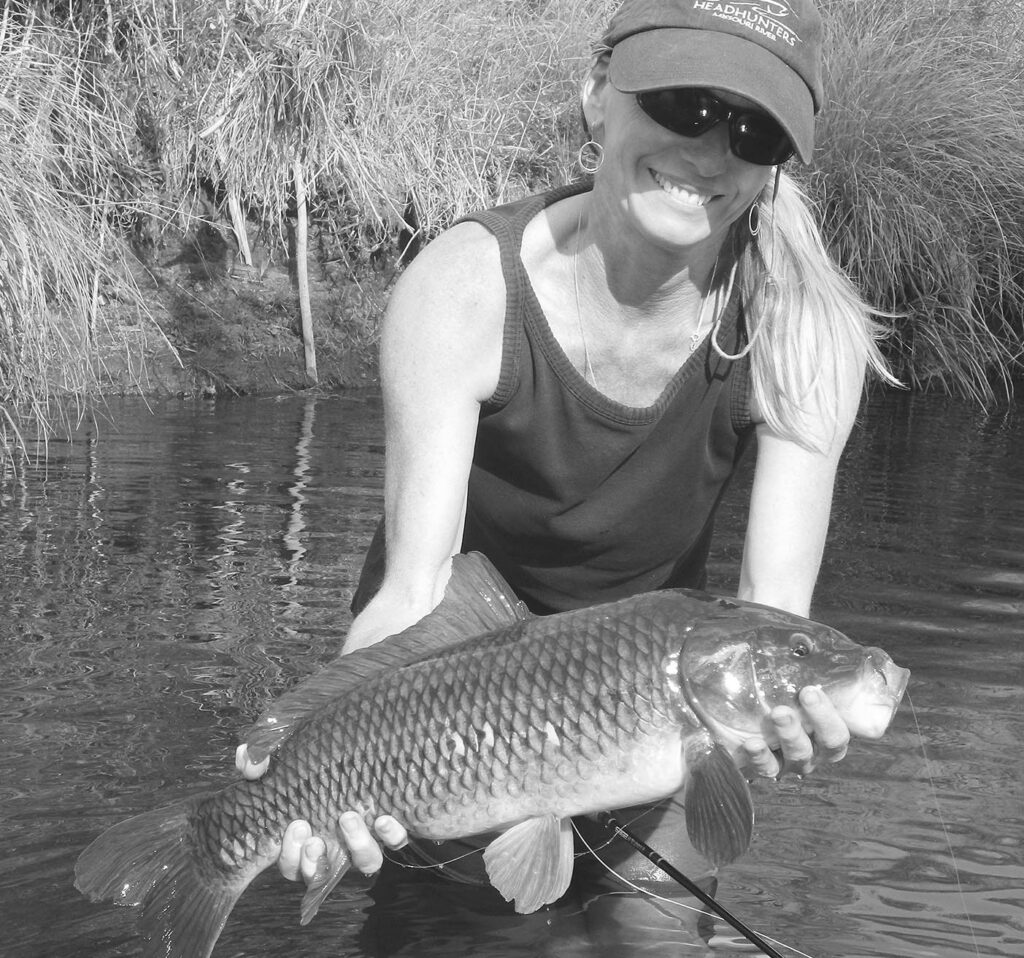
Bud: The flip side of the various disincentives that women interested in fly fishing have faced is the realization on the part of those who care about the sport and those who make their living from it that, duh, just over half the human population is female, and it might make sense to take them seriously. What kinds of positive incentives would help bring more women into the sport?
Lisa: More single, handsome, wealthy men on the river!
Seriously, what we need are not more incentives for women to get into fishing, but for more girls to be introduced to the outdoors. Study after study has shown that kids who have been immersed in nature before they hit adolescence become the adults who appreciate nature and tend to want to play in it and protect it. Parents naturally tend to be more protective of their little girls than of their little boys. Boys are encouraged to walk in the woods with their slingshots, climb trees, and even fish. Girls, as a norm, don’t share those experiences, but when they do, they are no less likely than a similarly raised boy to seek an outdoor lifestyle.
At least one-third to a half of my beginning students are women, and they have a really fun time . . . sometimes more so than the men! I have never figured out why these same women don’t get hooked as readily or deeply as the guys do.
I also think the manufacturers are doing a good job supplying the demand for women’s gear. In the past, companies took a stab at this by appealing to women’s vanity with plum-colored waders, vests with flowered piping, and pockets that were too slim and trim to fit any normal fly box. Most woman I know appreciated the concept, but most woman anglers I know felt this was degrading
I want to fish, and I don’t want to be pandered to. I really dislike it when women want to be treated as special. We are not a minority in the general population. We don’t need special gear. One of the coolest aspects of fly fishing is that it is not a gender-based sport. You don’t need to be big, strong, or athletic. It is all about finesse, observation, and thought. Like most things in life, fly fishing is what you make it.
Bud: You get high praise as a teacher of fly fishing to persons who are absolute beginners. Many of us get asked to take out a newbie and sort of do an initiation into the sport. What’s your advice for those of us who end up as informal instructors? Any tips for how to make the experience one that someone will want to repeat on their own?
Lisa: I love teaching newbies!!! It is so fun and rewarding to turn someone onto something new. I can’t tell you cool it is to roll over a rock and show an aquatic insect to someone who has never seen one before. Whether it is your spouse, child, or friend, the most important thing while teaching them is to keep it simple and keep it fun. Fly fishing isn’t hard — its just that there are a lot of parts. Start with just a few parts, then add more only when the person is ready.
Bud: You and your family aren’t just anglers. When I was a kid, I read and reread a story about an otter family, which spent as much time in and under the water as beside it, and the Cutters always have seemed to me to be the hominid equivalent. That includes your children, Teal and Haley. What other water adventures to you guys seek out, and what does being in the water do for your angling? What does a life in rivers teach?
Lisa: We are so lucky our kids love the outdoors as much as we do. I know there where times as they were growing up they questioned why we didn’t do some of the things “normal” families did. Grudgingly, we did take them to Disneyland. Once. The big payoff is we now have a grandson who has already, in his first year of life, been on numerous fishing and camping trips with his mom and dad.
Being on and in the water so much has taught me that there are no absolutes in nature. If you look closely, really closely, at what’s happening in the aquatic ecosystem as a whole, you come to the realization that what we know is so much less than what we don’t know. And much of what we know is wrong. The natural world is so linked together. And in our ignorance and arrogance, we humans seem very good at messing that up.
Bud: Your partnership with Ralph is pretty much sui generis in the angling world — about the only other example that comes to mind is Lee and Joan Wulff, and that was formed in and characteristic of another time. What’s it based on, and what has kept it going?
Lisa: Well, for starters, we are best friends and have been since 1975. Even though our personalities are quite different, we do pretty much everything together. I guess you can say we complement each other. Truth be told, I know I wouldn’t be where I am without Ralph. He is the mover, maker, and motivator, and I am very happy to be the creative worker bee. I knew the first day I met him life would never be boring.
Bud: Here we are at the obligatory Silly Tree question. If you were a tree, what kind of tree would you be?
Lisa: A cork tree. People can use me without killing me, and my bark is worth more than my bite.








